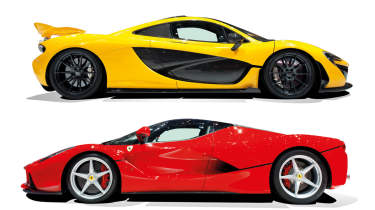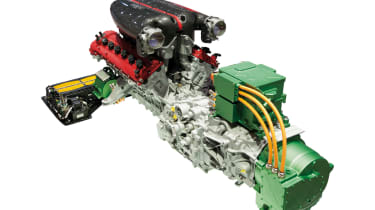LaFerrari v McLaren P1 - how the hypercars stack up
UPDATED: new details and videos added
It’s no coincidence that Ferrari and McLaren both chose the 2014 Geneva motor show to introduce the production versions of their part-hybrid hypercars. The timing was the only logical conclusion to a strange PR cold war that the two companies had been waging for months, neither wanting to show its hand before the other.
Originally we were told we were going to see the McLaren P1 in Paris 2013, its presence at the show later downgraded to that of an ‘exterior styling concept’. Then we were expecting the Ferrari in Detroit at the start of 2014; another literal no-show. In the end it became a game of ‘you show me yours and I’ll show you mine’, with the unveiling of the two cars within hours of each other in Geneva – and even exchange visits by senior executives from both sides to check out the opposition.
The waiting meant that many details had already leaked or been hinted at broadly enough to ensure there were relatively few surprises on press day. We already knew that both cars would use hybrid systems to boost performance. We knew that both would be made from carbonfibre, have a plethora of driver aids and have performance numbers and price tags to qualify them as genuine hypercars. Perhaps the biggest shock on the day was Ferrari’s choice of name for what had previously been ‘project F150’. Yes, it really is called LaFerrari.
But delving deeper into the spec of both cars, and speaking to senior engineers from both sides, also revealed some fundamental differences, both in terms of technology and the philosophies that have guided the cars’ creation.
Engines, bhp and 0-60 times
Let’s start with the basics. As it promised with the HY-KERS concept it showed four years ago, Ferrari has kept faith with the naturally aspirated V12. The company regards a 12-cylinder engine as a vital part of its most expensive models, and the LaFerrari uses a slightly boosted version of the F12’s 6.3-litre unit, sharing the same block and delivering its peak 789bhp at an astonishing 9000rpm; that despite a 13.5:1 compression ratio. Drive goes to the rear wheels via a seven-speed twin-clutch gearbox.
The electrical side of the powertrain consists of an ultra-compact Samsung lithium-ion battery pack, situated in the floor and supplying current to a motor mounted behind the transmission and driving the differential directly. A secondary generator, effectively a big alternator, recharges the battery from the engine. The electrical system adds 140kg in weight, the battery being 66kg, yet Ferrari says the car will weigh ‘about 1300kg’ (the Enzo was 1365kg). Total combined power is 950bhp.
Although McLaren is predictably keen to big up the differences between the P1 and the existing 12C, it’s fair to say that both cars are spun off the same core architecture. The P1 uses a development of the 12C’s carbonfibre tub, and the new car’s petrol power comes from a reworked version of the 12C’s 3.8-litre twin-turbocharged V8. It uses bigger turbos and far higher boost pressure to produce a massive 727bhp at 7500rpm in its own right.
Unlike Ferrari, McLaren has effectively combined the electric motor with the engine – it sits inside the engine block casing. This means it works via the seven-speed twin-clutch transmission and, unlike the Ferrari, its torque contribution is effectively multiplied by the gearbox. The battery pack is heavier than the Ferrari’s at 96kg and bulkier too – stacked vertically at the back of the passenger compartment. The full electrical system adds a claimed 170kg to the P1’s weight, bringing it up to 1395kg ‘dry’, while the total combined power is 903bhp. Unlike the Ferrari, the McLaren doesn’t use regenerative braking to recharge the battery pack – it’s fed either from the motor supplying charge in part-load or by plugging it into the mains. Also unlike Ferrari, McLaren claims a ‘pure electric’ e-mode for the P1, allowing it to drive on battery power for up to 12 miles, and at speeds of up to 100mph.
Aerodynamics

For all the headlines the hybrid systems will generate, they’re no more advanced than the engineering elsewhere in both cars. Each is a technical tour de force, engineered to enable drivers to access their astonishing levels of performance. In the McLaren, that’s meant the development of an astonishingly complicated system of active aerodynamics, including moveable wing elements, to help stabilise the car in hard use.
‘We set the aerodynamic targets very early,’ explains Dan Parry-Williams, McLaren’s chief design engineer. ‘We looked at race cars and worked out what was possible. We targeted 600kg of downforce, and we wanted it around the speed that we’ve got it [from 161mph]. Of course, the problem with downforce is that you can have too much of it – if you double the speed you quadruple the aerodynamic downforce and you soon reach a point where you’ve got more than you can handle. That’s the great thing about active aerodynamics – we can just shed that downforce and manage it at high speed. And we can manage the dynamics of the car through a corner – we can change the aero balance depending on whether you’re in the braking phase or mid-corner or accelerating out.’
Since this article was first published, we have driven both cars. Here's the McLaren P1:
By contrast, the rear deck of the Ferrari looks almost naked, without anything like the McLaren’s vast, hydraulically operated rear wing.
‘We don’t need it,’ says Roberto Fedeli, Ferrari’s senior technical vice president. ‘This is not the first time we are using active aerodynamics. For the 599XX Evo we had a wing on the car which we managed in order to obtain the right load. We learned a lot from that, and it’s the same philosophy we’re using on LaFerrari – without a wing but with a spoiler on the back of the car, and with moveable surfaces on the underbody. The vehicle dynamics system manages the load and drag – the ECU manages all the surfaces in order to find the maximum performance, the maximum load you can have on the wheels.’
The Ferrari’s separate electrical motor has given it what initially looks like a surprising amount of mass hung behind the rear axle-line, but Fedeli insists the advantages outweigh any problems: ‘We have 59 per cent of [static] weight on the rear of the car [the McLaren has 58 per cent]. And because we don’t have any traction on the front it’s okay for us. The main reason we put the motor in that position is because that’s where we have the final drive of the gearbox, and we don’t want to go through the gearbox with the motor in order not to lose efficiency. In that position we’re putting the torque of the electric motor directly – or very close – to the wheels.’
Chassis
Unsurprisingly, both cars are packed with active aids to help drivers access the phenomenal performance. As in all its recent cars, Ferrari’s ‘manettino’ system offers a choice of suspension and stability control settings, with five levels including an ‘on your own’ mode that switches the stability control fully off. McLaren has opted to include both an F1-style DRS (Drag Reduction System) button to enable the rear wing’s drag to be trimmed by a quarter, and also something it is calling the ‘Instant Power Assist System’ – a push-to-pass button that allows the driver to manually engage the electric motor. Both systems can also work automatically if preferred.
The P1’s adjustable-height suspension is seen as one of the most important changes over the lesser McLaren 12C. This can alter the car’s ride height as it moves, with Race mode dropping it as much as 50mm.
‘It’s definitely the enabling technology for us,’ says Parry-Williams. ‘When you want to run just 65mm from the ground you need exceptional control of the platform to maintain stability with the aerodynamic loads we are running. That means being able to increase the stiffness of the suspension by multiples, 350 per cent in the case of roll stiffness. That meant we had to devise a radically different suspension system. It was a huge challenge.’
What both sides agree on is that the performance of their cars shouldn’t be measured purely in straight-line terms. As with any hybrid system, once the battery is exhausted – which can be by simply pinning the throttle – the electrical gubbins won’t be adding anything other than weight to the car.
‘We designed the batteries to have a perfect balance between what we are consuming in energy and what we are recharging at the Fiorano track – that is always the ideal for us,’ says Fedeli, ‘but the system needs to regenerate the energy… If you go to Nardo and you push the throttle all the way and want to go at speed for half an hour then it’s not possible for sure – you won’t get a chance to regenerate.’
Parry-Williams is in agreement: ‘Absolutely right – it’s lap time. When we started there was no system out there we could buy, but we convinced ourselves that we could develop a hybrid system that would earn its keep – that would make the car go faster not slower. That was always the critical test, and it’s one the car passes. I think we’re going to see more and more performance being measured on track – that’s what these cars are designed for, with active aero and active suspension.’
This begs the obvious question, of course. Which will go quicker, and why?
‘Well us, of course,’ says Parry-Williams, ‘but then I would say that, wouldn’t I? For one thing, we’ve got a more powerful electric motor, which is geared through the transmission. We multiply the torque from the electric motor, which gives us this instant torque in every gear…. I think the culture in our business is that we don’t want to over-sell what we can do, we want to make sure we can absolutely back it up. I’m confident we can definitely achieve the figures that we’ve set.’
Fedeli is slightly more diplomatic, although you sense no less confident. ‘I don’t know,’ he says, ‘I think that’s something we can only speak about later. The most important thing is that this car must be the most enjoyable for our customers. Performance is very important; we are Ferrari, we know that. But when a customer buys the car the main reason will be because he wants to enjoy himself. Enjoyment and performance are sometimes the same, sometimes not.’
Price
When it comes to sales, Ferrari has already stolen a march. Maranello knows how to manage its ‘collectors’ better than anybody else, and the company has had no trouble selling the 499 LaFerraris it intends to produce – despite a €1.2m price tag (£1,037,000 at current exchange rates). McLaren’s early plans to produce 500 P1s were subsequently downgraded to 375, with the official line being that this is because buyers valued exclusivity more than anything else. The P1 costs £866,000, meaning that – presuming all get sold – McLaren will make about £21m less from its hypercar project than Ferrari will from the LaFerrari.
Rest assured, we’ll move heaven and earth to get these cars together.





